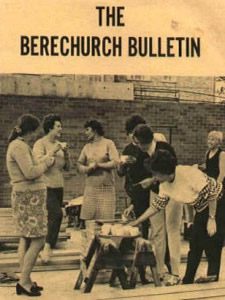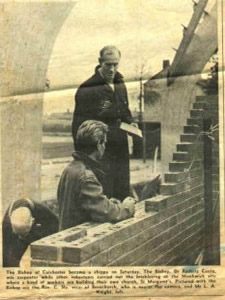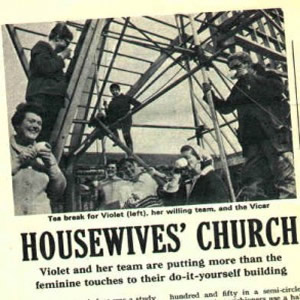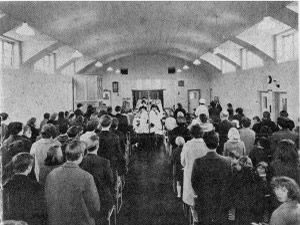History
1020
There has been a church here for almost a thousand years, in one form or another. Originally a small wooden chapel, it catered for those working in the Berechurch area (Berechurch means “Church in the Cornfields”) to save them having to walk all the way to St John’s Abbey to worship.
1520
St. Michael and All Saints Church is now a brick and stone building with an embattled West Tower. The original foundation is 14th Century, but it was rebuilt in 1500 and again in 1872.
Berechurch Hall, the mansion of West Donyland, is first mentioned as being acquired by Sir Thomas Audley, Lord Chancellor to King Henry VIII and Speaker of the House of Commons, after St. John’s Abbey was dissolved. Members of the family built the little family church, where many of them are buried.
It is recorded that in 1537 the Parish of Berechurch numbered 37 people. Thomas Audley had a very dark side to his character. It is said that on his black marble gravestone, which is situated in another part of the county, it is written, ‘That the stone was no blacker nor harder than his heart’!
1960
The post World War Two years saw a boom in building and the population of Colchester rapidly increased with the influx of people displaced from London. New estates sprang up to the South. The Monkwick Estate was fully within the ancient parish of Berechurch, swelling the population to several thousand. As part of the provision for the new community a dual-purpose Church Hall (church on Sunday, community hall mid-week) and Vicarage were built at the junction of Mersea Road and Stansted Road.
1970
The decision was made that a new church building should be built, but rather than hiring a construction company the congregation took on the bulk of the construction work themselves – yes, we built our own church!
The lorry driver’s face was a study the day he and his load of 8,000 bricks arrived at the site of the new church, for waiting to unload the bricks were a group of eager housewives. “You’re never going to do this yourselves!” gasped the lorry driver. “Why not?” retorted the group proudly. “We’re helping to build the church.”
And since that bitterly cold day the ladies of St. Margarets Church, near Colchester, Essex, have never once sat back and let their husbands do all the heavy work for their “do-it-themselves” church. Instead, they’ve put on their jeans and boots, rolled up their sleeves and got cracking with jobs like unloading lorries of bricks and timber, preparing the strips for the roof, and finishing off all the brickwork which their husbands learnt how to lay at evening classes.
“The men could only work in the evenings and weekends so it would have taken them far longer if we hadn’t helped,” said Violet Radley, an industrious corner-stone of the housewives’ building corps. “It was our Vicar who suggested we unload the lorries because they always delivered during the day when our men weren’t around. Altogether we’ve unloaded over 45,000 bricks, dozens of 24foot long lengths of timber and eight half-inch glass doors. It took eight of us to lift each one!
“We had to ask that very first lorry driver how to unload his bricks. He told us how to hold three together like a wafer of ice cream. Then we formed a chain to the hut where the materials were being stored and passed them along. I won’t say we didn’t drop any bricks. But at least none landed on our toes!” Violet, a cheery forty-two year old with two teenage children. recalled their first “brickies” experience as we stood on the muddy building site beneath the church’s skeleton frame with the main roof beams soaring into the sky.
In the hut, ten of the housewives were cutting the strips with an electric saw. Later, in her comfortable home a stone’s throw from the site, Violet showed me photos of the completed model of the church. Its design is futuristic with a special triangular chimney for the light to beam through to the altar area. It will seat two hundred and fifty in a semi-circle.

At present, parishioners use a hall by the building site for both their worship and social events. The idea to build their own church came to Jean Sly, the Vicar’s pretty young wife, in the middle of the night. She woke up her husband who thought the scheme crazy. But next morning, after going into the money aspect of things, he changed his mind. When the church is finished, by the end of next year, the bill should be about £15,000 – under half the normal cost.
“When I first heard Mr Sly say we would do it ourselves, I thought: crumbs we’ll never manage,” said Violet. Now she and the other ladies, there’s a hard core of about a dozen, like to think that the men could not have managed without them.
To protect her hands against the rough work, Violet started off wearing rubber gloves. But she got through so many pairs, that she settled for some old leather gardening gloves. And to help her husband, Fred, a forty-four year old electrician, who works nights on the site, to beat the cold during the wintry months, she knitted him a bobble hat and half-mittens without finger covering. The outfit was a huge success and Violet found herself knitting for the other men as well.
Like the other husbands, Fred is justifiably proud of his wife’s achievements. “When I tell him what we’ve been doing on the site, he’ll say, “That’s not women’s work”. Then we both laugh and next day all of us housewives carry on as usual,” said Violet, smiling.
Her son, Andrew, helps at the site too, and daughter Linda has made a neat purple and orange embroidered hassock, one of two hundred the ladies are sewing for the church. “All our families have been involved with the project. Even the babies and  toddlers, as they’re brought along to the site so that their mums can do some work;” said Violet.
toddlers, as they’re brought along to the site so that their mums can do some work;” said Violet.
The ladies’ final task, apart from their continuous fund-raising efforts, is to lay glass mosaic on the floor of the altar dais and church entrance. “After it’s all finished we’ll have loads of our own decorating and gardening to do,” said Violet. “We’ve not had a minute to look after our own homes.”
GLENDA NIELD
After 6 years construction the new building was opened in 1973, the existing dual use building becoming simply St. Margaret’s Hall.
The old St. Michael’s Church was now redundant and sold off, although old Audley Chapel was kept in its original state and can still be visited by arrangement in writing to Mr Roy Tricker, Churches Conservation Trust, 329 Felixstowe Road, Ipswich, IP3 9BU.
